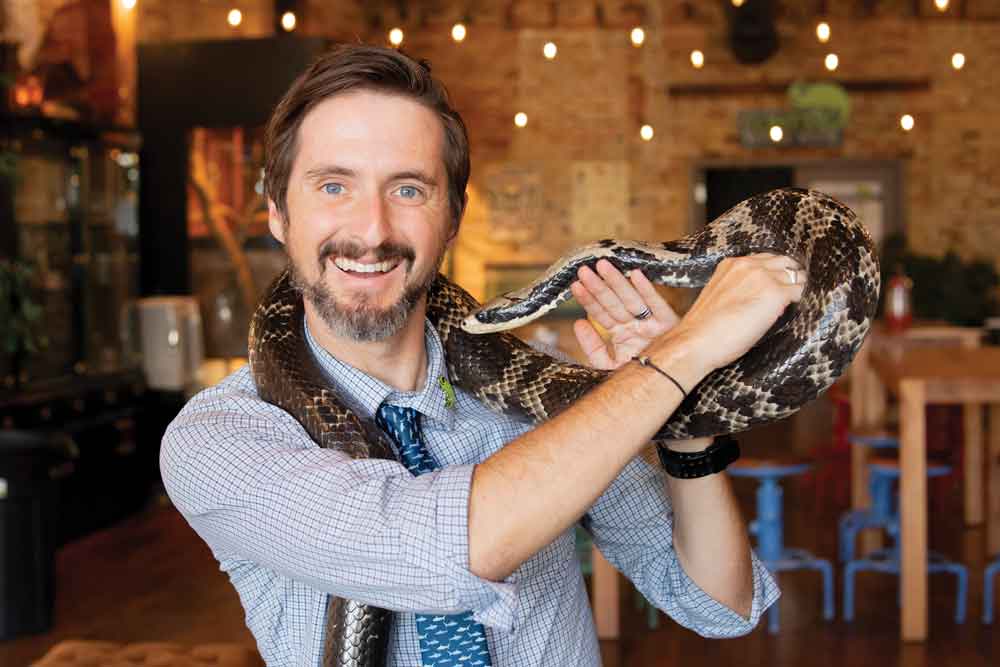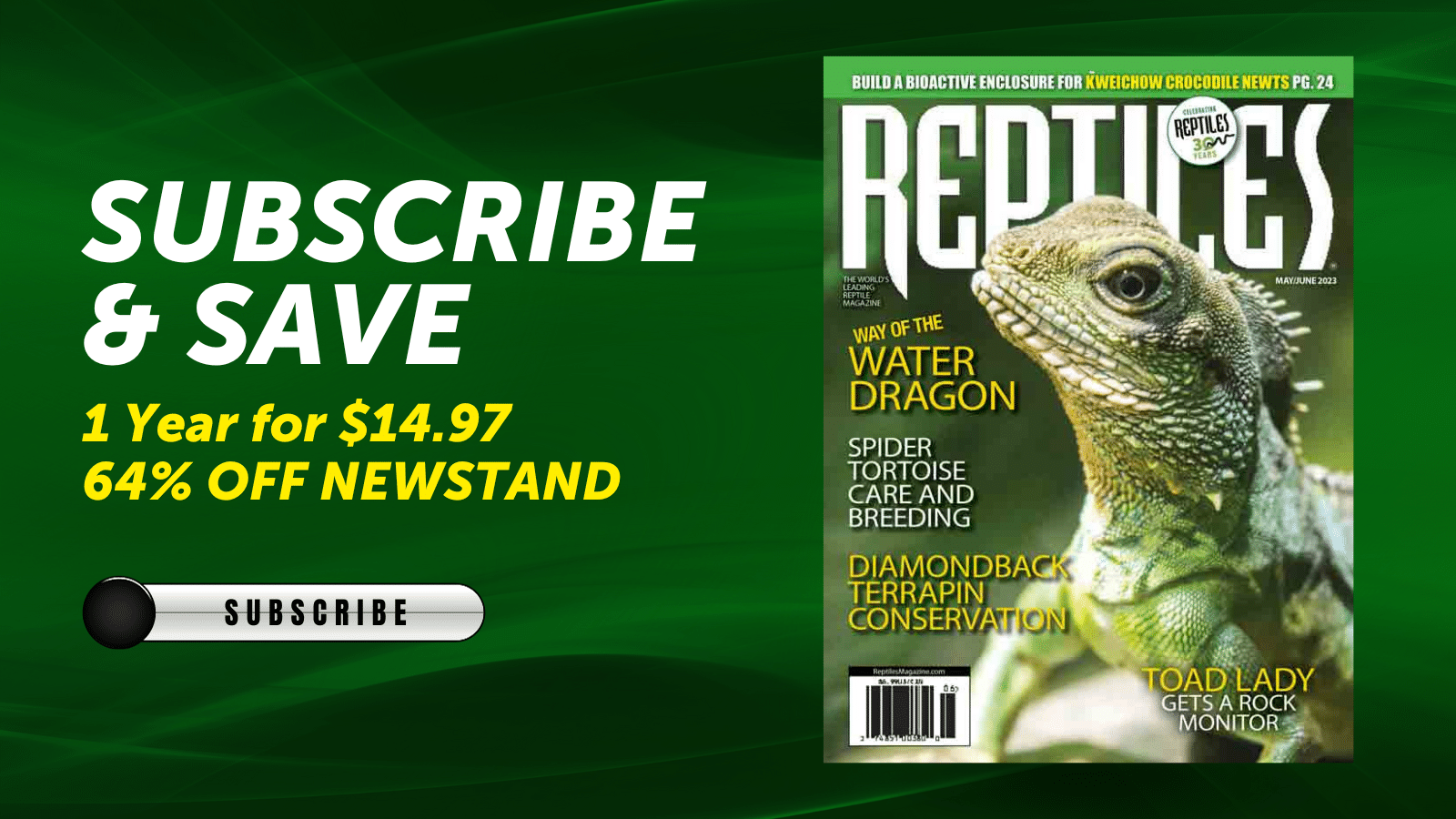Located in Springville, Utah, Clint’s Reptile Room is a unique educational facility dedicated to teaching the public about reptiles, amphibians, and other wonders of zoology.
When searching for information about a particular reptile or amphibian, the internet has long become the go-to vehicle for accomplishing this task. One excellent YouTube channel that frequently pops up on searches is Clint’s Reptiles. Founded in 2017, Clint’s Reptiles has 750K subscribers and 500 videos, a number that is growing daily. During my journey to interview various successful content creators, four elements remain constant.
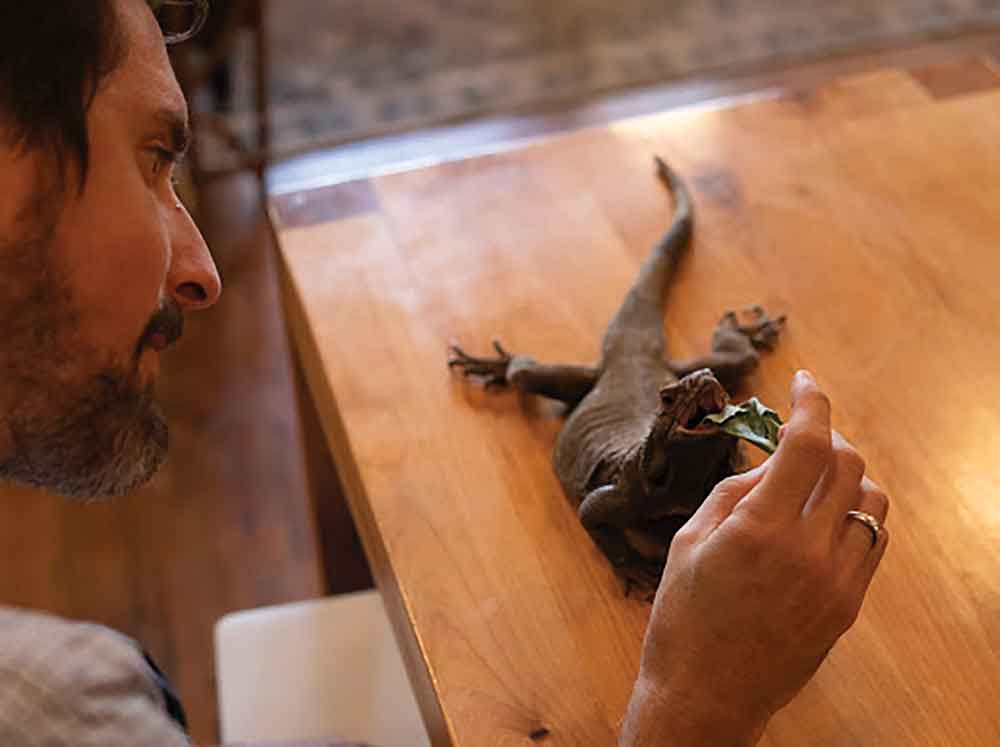
When Clint was a child, his first pets were seven bullfrog tadpoles that he caught in a lake. His first pet reptiles were garter snakes. “If there is one thing that I could encourage the reptile hobby to do, it is to be very kind and patient with the mistakes that people make who are new to the hobby.” Photo courtesy Clint’s Reptiles
Knowledge of the subject matter, high-quality production, engaging screen presence, and a unique angle for presenting material are factors that separate the competition. Sitting behind a desk and wearing his trademark tie, surrounded by model dinosaurs, fossils, and other biological curiosities, Clint Laidlaw presents his advanced level knowledge on reptiles, amphibians, sharks, prehistoric life, invertebrates, and the list goes on. In addition to the YouTube channel, Clint and his wife Leisha also own and operate Clint’s Reptile Room. Located in Springville, Utah, Clint’s Reptile Room is a unique educational facility dedicated to teaching the public about reptiles, amphibians, and other wonders of zoology.
Foster Reves: Hello Clint and thank you for taking time to engage in this interview. Tell us about some of your early experiences with reptiles and other animals?
Clint Laidlaw: I have been reading REPTILES magazine since I was 10 or 12 years old, always had a subscription, so this is exciting. I have been interested in animals my entire life. My earliest reptile specific memory was when I was probably about 4 or 5 years old. I grew up by a lake in Colorado. My neighbors lived in a house that backed right up to the lake. They would get quite a few snakes in their backyard. Those were the first reptiles that I can really remember interacting with at all. I wound up putting one in a jar and bringing it home. After eating dinner, I came back out and discovered that jars without lids do not hold snakes. My first pets that I ever kept were seven bullfrog tadpoles that we caught in the lake. After a year of raising bullfrog tadpoles, I switched those out for crayfish. The next year we switched those out for three garter snakes. Those were my first real pet reptiles.
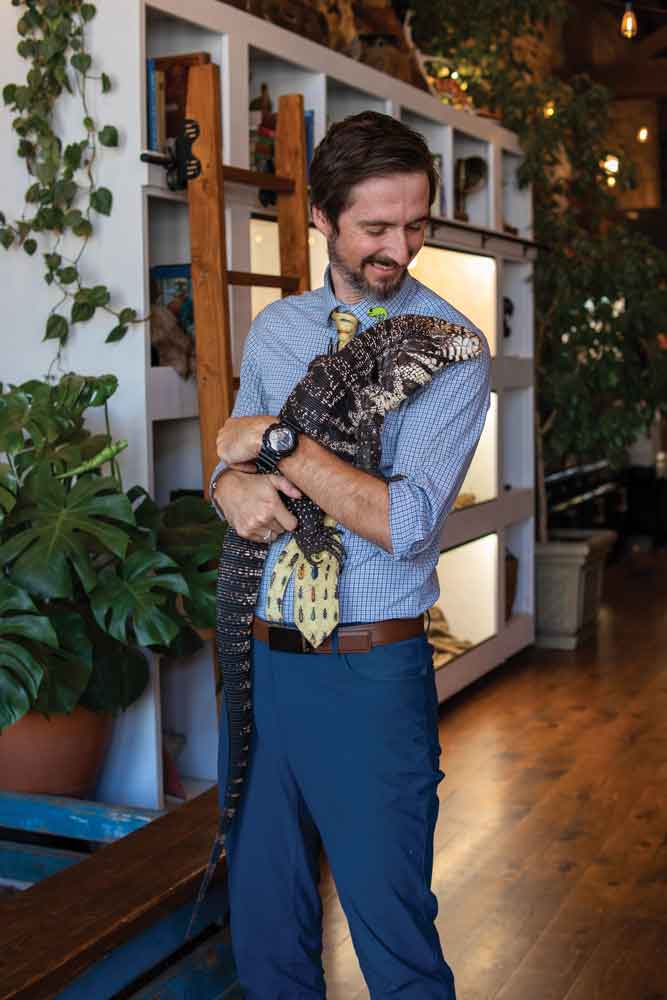
Clint has an undergraduate degree in biology and zoology, holds a master’s degree in evolutionary ecology and earned his Ph.D in biology. Photo courtesy Clint’s Reptiles
FR: When did you first delve into breeding reptiles and amphibians, beyond the backyard lakeside era?
CL: I pretty much always had some reptiles, a tarantula, and things like that. I worked at Disney’s Animal Kingdom and then was a missionary for two years in Peru, before moving out here. I had to rehome everything before leaving. When I first got married, I didn’t have any reptiles and didn’t start getting very many until I started teaching at the university. During my undergraduate education in zoology, I had seen one live animal in a classroom, and it was hibernating. My professors had somehow managed to suck all the fun out of my favorite subject. When I started teaching at the university, I wanted to have some animals that the students could interact with. That is really when I started to get quite a few reptiles. I was never really into breeding, especially since I had no connection with anybody who wanted to buy one. I had several crested geckos and ball pythons and started to breed those. In addition, I was a very poor graduate student and there were morphs that I wanted but couldn’t afford. I still breed zebra skinks, ball pythons, keel-bellied lizards, geckos, and a few other odds and ends. This year I only paired one snake, as well as emerald tree skinks. I started doing animal presentations 10 years ago and reached a point where I would rather have a lot of diversity of things to show people. The goal of the Reptile Room is to bring a large variety of different species of reptiles, amphibians, and arthropods to a huge number of people that never would have been able to experience them otherwise.
FR: One question that I almost always like to ask is which species currently in the trade would you like to see hobbyists and breeders focus on more?
CL: Emerald tree skinks. They are entirely un-handleable, you can’t chase one around or scoop it up, however they want to interact with you. If you let them do things on their terms, it’s probably one of the best imaginable experiences that you could have with an animal. It is only doing what it wants to do, and it wants to hang out with you. I can show you right now if you want to see (Clint walks over to his ETS vivarium and opens the door). “Hi Peter, come on out buddy.” (The skink immediately jumps onto Clint and runs up his arm). Why would a little lizard be like this? It doesn’t make sense. If any morphs start showing up, this would be unbelievable. In addition, chuckwallas, Peters banded skinks, false water cobras, super dwarf reticulated pythons, Cape house snakes, a long list of things that I believe are just unbelievable pets that people don’t appreciate that much. As far as things that we could lose from the hobby, there are a lot of things that we are producing but in very small populations. Continuous imports are also not a sustainable strategy. I always encourage people, if you are going to get imports, you should be an experienced breeder with similar species. You are getting them specifically to produce a captive population of them, not to just keep.

The Emerald tree skink is one of the reptiles that Clint thinks hobbyists and breeders should focus more on. Photo courtesy Clint’s Reptiles
FR: If you could only keep one herp, what would it be?
CL: I would probably keep false water cobras. The interaction with an animal is very important to me, and snakes are on sort of another level. The false water is enormous, they are intelligent, interactive, they are so special.
FR: Unlike the vast majority of
reptile and amphibian enthusiasts you are an actual biologist. Tell us a little about your educational background and experience in the academic field.
CL: I got my undergraduate degree in biology and zoology because I love learning about animals. When I was finishing high school and starting college, I did not see a good path forward to having a career with reptiles. Near the end of my senior year, I was thinking about going to law school. That was my plan because I also liked public speaking, debate, that kind of stuff, and you could make a living as a lawyer. When I was in my senior year at the university, I was watching an episode of “Crocodile Hunter Diaries” and I thought that I would be happier doing something with animals. After graduating, I was out of school for four years. I discovered during those four years that if I wasn’t learning something new then I wasn’t very happy. I took the biology GRE, which is a placement exam for people wanting to go into biology, and I scored extremely high in evolution and ecology. I always just thought that evolution and ecology classes were super easy, so I got my master’s degree in evolutionary ecology. During my master’s, I discovered that I had a real passion for teaching biology, so I got my Ph.D in biology. My research focus shifted to evolution education and how to teach evolution so that people could accept it. I did my master’s and Ph.D at a religious institution. I had been a TA for other professors, and they were at war with their students. At war, students were storming out of the classroom, giving snarky answers on their tests, and so forth. Then I started teaching at the same institution. My background was in evolutionary ecology, so my class was hugely evolution centered. I asked myself why they are fine when I teach evolution but not other faculty members? That’s when I really started to dig into a Ph.D on what it is that I’m doing that is changing this. Currently I am not teaching at university because I don’t have time.
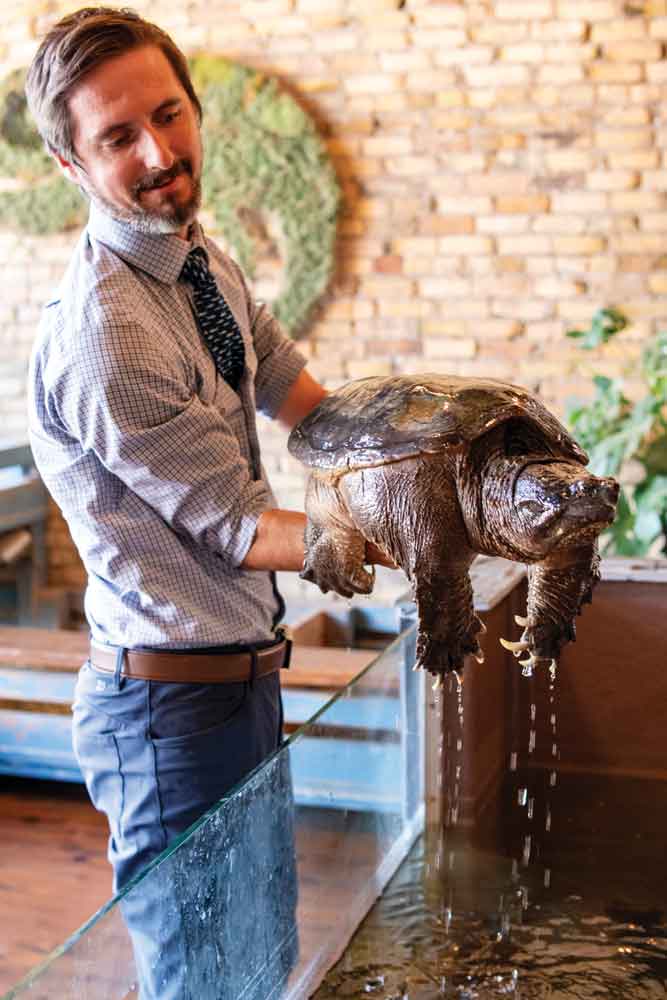
Clint’s Reptile Room is open to the public just two days a week. Photo courtesy Clint’s Reptiles
At Clint’s Reptile Room, we are celebrating our fifth year anniversary this year. We are currently offering university level continuing education classes here at the Reptile Room. I would love to take a university level geology class, but I don’t want to enroll in a university to do it. I just want to take the one class, and I think that there are a lot of people like that, so that is something that we just started doing this fall.
FR: Clint’s Reptile Room is an innovative concept. Are there any specific factors that lead up to creating such a unique business idea?
CL: I have been doing traveling presentations for about 10 years. I only advertised for one summer, but just by word of mouth, I constantly had requests. I was still teaching at the university, finishing my Ph.D, and I had children. I’m really passionate about those presentations, but never had time to do very many. Right around the time that I was finishing my Ph.D, I found a job listing for the educational director at our local zoo. It was a unique set of requirements they had for this position, and I had them all. I was just over the moon excited about it. My wife and I were jumping up and down, and then we noticed that the job listing was eight years old. It was quite deflating; it was like well what if we created that? In addition, the unexpected success of our YouTube Channel, and support of our fans, we had a little bit of seed money to get started. I was still in graduate school at the time, I was teaching at two universities as well as a charter high school. I had a lot going on, but we decided to go ahead. We didn’t have a lot of money, we didn’t have a lot of time, we just asked, is this something that you guys are willing to get behind? The response was overwhelming, and they put their money where their mouth was. They contributed $10,000 dollars and we had about $10,000 dollars of our own money. We made it through an entire pandemic, and it’s going stronger than ever. We just did our second year of summer camps in addition to our first adult summer camp; it is incredible what has happened.
FR: Approximately how many visitors would you say that your facility receives on average?
CL: I would say right now, we probably have 200 to 300 visitors a week. We are only open two days a week to the public. I don’t want to price people out of being able to come here. I was poor my entire adult life and I’ve got four kids. I don’t want to make it the kind of place that I wouldn’t be able to afford to take my family. In addition, because it is such a hands-on experience, the animals need a lot of down time.
FR: What inspired you to develop a YouTube channel and what advice would you give to others striving to do the same?
CL: I’m terrible with technology. I would have loved to create a YouTube channel like we have but I can’t edit a video. My friends Jason and Will, they are both into tech businesses, and we used to go to lunch once a week. One day Jason said, I’ve been trying to think of a business that we could all do together, and I said, “I will bring nothing to this”. He said, “it involves you quite a lot”, and his idea was to create a reptile YouTube channel. I started developing all the content for it. He started learning how to edit videos, and Will’s wife, Michelle, a professional photographer, became our videographer. Our big picture dream with the YouTube Channel was to make the first video, Top 5 Reptiles for Beginners, and then make several follow-up videos about each of the five animals, and that would be it. We were hoping for some affiliate links and maybe some ads and maybe earn enough money so that occasionally our three families could get together and get an Airbnb and hang out for a weekend. A few months later, our channel had really started to grow. We released one video and later we released a second video. It started to grow fast. I did a presentation at a birthday party, and they were filming me intensely. So, after the party I asked them about that. They had a family vlog. They made six figures on YouTube! I didn’t even know that was a thing. I went to YouTube to learn things. I was aware of Brian Barczyk, but that was pretty much it.
A lot of people who start channels want to be famous, but it is hard to do. The reality is even if a channel is growing relatively quickly, you are still doing it maybe for years for like, $10.00 a week. It is a full-time job. You had better have something to say that you can talk about for years. If you are on a once-a-week schedule you need to stick to that. A Netflix series averages eight episodes a year, a YouTube series is like 52 episodes a year. From the very beginning I made efforts to shift from talking about specific pet reptiles. I like reptiles, but I don’t want to do that for my whole life. When it comes to talking about animals more generally, I will do that every day forever. I have never kept everything that I talk about, but then again, I’m not putting out care guides. I’m just trying to give a feel for is this a good fit? There are animals that I have kept that I feel very confident about, but I want to keep it to the level that I feel will give you good information, and not try to say more than that.
FR: Your trademark style care video featuring the five components of care to consider before obtaining a pet are very popular. These components are handleability, care, hardiness, availability, and up-front costs for our readers who may be unaware. Have you ever received any criticism for, what a logical person might consider anyway, an obvious downside?
CL: Our community is unbelievably positive. I don’t get too many haters, and it’s kind of amazing. The one place where I get the most baseless complaints are about the total scores. An animal can be great, but it is difficult to get one and they are expensive. The thing about the categories is the total score is not a measure of how to care for. What matters is the individual category score and which categories matter to you. If you have connections and money is no object, you can ignore availability for example. However, for a lot of people, not being able to find one or having to pay $1000.00 will be a total deal breaker. The overall score is just an average of the five categories.
FR: Many of your videos feature collaborations with other well-known influencers. What are some of your favorite memories with these experiences?
CL: The first collaboration that I ever did with another Reptile YouTuber was with Emily Roberts of Snake Discovery. When we did our first collaboration nobody had ever heard of either of us. I had made quite a few videos on general care of reptiles, but most of my life I have been on an island as far as reptile keepers go.
My wife follows a lot of crafting and card making channels, and they had these great relationships with each other. I was like, that is the kind of community that we all should have. She was the first one who I found, and then Dāv Kaufman around the same time. So, I got together with Emily. She had just released a video about every snake species that she had, and I wanted to do a top five snakes at Snake Discovery video.
When I showed up however something was wrong with one of the snakes. I can’t remember if it was a stuck shed or what. Emily suggested that we put false water cobras on the list. We talked about it a little bit. She put one in my hands, and you can see in that video. I am absolutely in love. False water cobras are not just my favorite snakes to keep, but are my favorite snake period. I don’t think that they are the best snakes for people across the board, there are others like African house snakes, or super dwarf retics, for that. It was right there during my first collaboration. Now I have a pair, and my female is like 8 ft long, she is just unbelievable.
FR: The five-year-old child in me demands that I ask this this, what is your favorite extinct dinosaur?
CL: What an excellent question to be asking people period, and what a great clarification. For some reason people stop asking that question, and that is not right. I wish that I had a more obscure answer, but the correct answer is Tyrannosaurus rex.
FR: Clint, again thank you for taking time to participate in this interview. Are there any parting words that you would like to share with our readers?
CL: If there is one thing that I could encourage the reptile hobby to do, it is to be very kind and patient with the mistakes that people make who are new to the hobby. You will see people who are exposing their mistakes, they are new and all of us have made some mistakes. We need this hobby to grow and be more mainstream. If we don’t want to see it get destroyed, we need to be inviting. I think that as more people gain an appreciation for these incredible animals, not only will there be better technology to help us as keepers and more opportunity, but laws will also be more favorable for us. More people will genuinely care about the species and will work harder to preserve them in the wild. It would be very hard to find anybody who is passionate about reptile keeping who isn’t equally passionate about having these animals persist in the wild.

